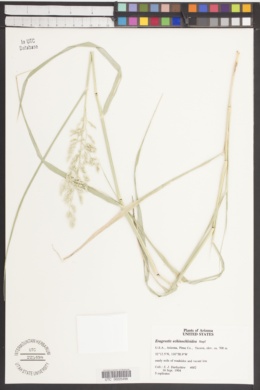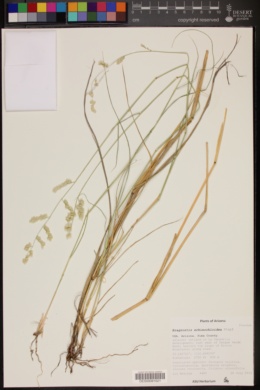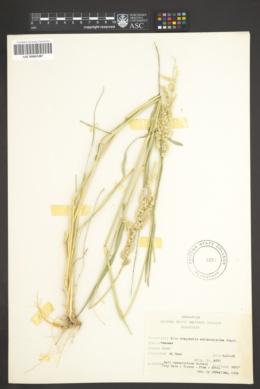Eragrostis echinochloidea
|
|
|
|
Family: Poaceae
African Love Grass, more...African lovegrass, lovegrass, Tickgrass
|
Plants perennial; cespitose, with innovations. Culms 30-100 cm, erect to geniculate, with narrow, sunken glandular bands. Sheaths sometimes glandular, apices hairy, hairs to 5 mm; ligules 0.4-1 mm; blades 5-21 cm long, 2-6(7) mm wide, flat to involute, with small crateriform glands on the keels and veins, sparsely pilose adaxially. Panicles 4-19 cm long, 0.8-7 cm wide, oblong to ovate, glomerate, spikelets clustered in 1-sided groups; primary branches 0.5-7.5 cm, diverging 10-90° from the rachises, angled, sinuous, glandular; pulvini hairy, hairs to 2 mm; pedicels 0.2-2 mm, stout, erect, without a narrow band or abscission line near the apices. Spikelets 2-5 mm long, 2-3.5 mm wide, broadly ovate, greenish, stramineous to plumbeous, with 7-14 florets; disarticulation basipetal, glumes persistent. Glumes subequal, 1.7-2.2 mm, ovate, membranous, keels with small crateriform glands, apices acute to acuminate; lemmas 1.8-2.3 mm, broadly ovate to orbicular, chartaceous, keels with small crateriform glands, apices acute to obtuse; paleas 1.7-2.2 mm, chartaceous, each side with a broad wing at the base, wings often projecting beyond the lemma bases, apices acute; anthers 3, 0.5-0.9 mm, yellowish. Caryopses 0.8-1.1 mm, ellipsoid, reddish-brown. 2n = 30. Eragrostis echinochloidea is native to southern Africa. It is now established in Arizona, growing in gravel soils, often along roadsides and in sidewalks, from 700-1000 m. It has also been found in Prince Georges County, Maryland. Dr. David Bogler, USDA NRCS PLANTS Database Perennials, Terrestrial, not aquatic, Stems nodes swollen or brittle, Stems erect or ascending, Stems geniculate, decumbent, or lax, sometimes rooting at nodes, Stems caespitose, tufted, or clustered, Stems terete, rou nd in cross section, or polygonal, Plants viscid, sticky, glandular-hairy, Stem internodes solid or spongy, Stem internodes hollow, Stems with inflorescence less than 1 m tall, Stems, culms, or scapes exceeding basal leaves, Leaves mostly basal, below middle of stem, Leaves mostly cauline, Leaves sheathing at base, Leaf sheath mostly open, or loose, Leaf sheath or blade keeled, Leaf sheath and blade differentiated, Leaf blades linear, Leaf blades 2-10 mm wide, Leaf blades mostly flat, Leaf blade margins folded, involute, or conduplicate, Leaf blades mostly glabrous, Ligule present, Ligule a fringe of hairs, Inflorescence terminal, Inflorescence an open panicle, openly paniculate, branches spreading, Inflorescence a contracted panicle, narrowly paniculate, branches appressed or ascending, Inflorescence solitary, with 1 spike, fascicle, glomerule, head, or cluster per stem or culm, Inflorescence branches more than 10 to numerous, Flowers bisexual, Spikelets pedicellate, Spik elets laterally compressed, Spikelet less than 3 mm wide, Spikelets with 3-7 florets, Spikelets with 8-40 florets, Spikelets solitary at rachis nodes, Spikelets all alike and fertille, Spikelets bisexual, Spikelets disarticulating above the glumes, glumes persistent, Spikelets disarticulating beneath or between the florets, Rachilla or pedicel glabrous, Glumes present, empty bracts, Glumes 2 clearly present, Glumes equal or subequal, Glumes equal to or longer than adjacent lemma, Glumes keeled or winged, Glumes glandular, Glumes 3 nerved, Lemmas thin, chartaceous, hyaline, cartilaginous, or membranous, Lemma similar in texture to glumes, Lemma 3 nerved, Lemma glabrous, Lemma apex acute or acuminate, Lemma awnless, Lemma margins thin, lying flat, Lemma straight, Palea present, well developed, Palea membranous, hyaline, Palea shorter than lemma, Palea 2 nerved or 2 keeled, Palea keels winged, scabrous, or ciliate, Stamens 3, Styles 2-fid, deeply 2-branched, Stigmas 2, Fruit - caryopsis, Caryopsis ellipsoid, longitudinally grooved, hilum long-linear.
FNA 2003, Gould 1980 Common Name: African lovegrass Duration: Perennial Nativity: Non-Native Lifeform: Graminoid General: Perennial bunchgrass with erect to geniculate stems 30-100 cm, with narrow, sunken glandular bands. Vegetative: Sheaths sometimes glandular; sheath apices hairy, the hairs to 5 mm; ligules 0.4-1 mm; blades 5-21 cm long, 2-6 mm wide, flat to involute with small glands on keels and veins, sparsely pilose on the upper surface. Inflorescence: Panicles 4-19 cm long, 1-7 cm wide, oblong to ovate, spikelets clustered in 1-sided groups, primary branches 0.5-7.5 cm, diverging 10-90 degrees from the rachises, angled, sinuous, glandular; pulvini hairy, hairs to 2 mm, pedicels 0.5-2 mm, stout, erect; spikelets 2-5 mm long, 2-3.5 mm wide, broadly ovate, greenish, stramineous with 7-14 florets that disarticulate from the apex toward the base; persistent glumes subequal, 1.5-2.5 mm, ovate, membranous with acute apices, lemmas 1.5-2.5 mm, broadly ovate to orbicular, keels with small glands, paleas 1.5-2.5 mm, each side with a broad wing at the base, projecting beyond the lemma bases; caryopsis ellipsoid, reddish brown. Ecology: Found in gravel soils, often in disturbed areas from 2,000-3,500 ft (610-1067 m); flowers June-October. Distribution: Native to s Africa; naturalized in s AZ. Notes: Eragrostis species have branched inflorescences (panicles), multiple, bisexual flowers (florets) per spikelet and components of the spikelets are for the most part hairless and awnless. E. echinochloidea a perennial bunchgrass, distinctive with its short, wide, roundish spikelets clustered in one sided groups, with many spikelets on each branch. The spikelets are much shorter in length than the similar E. superba. Ethnobotany: Unknown Etymology: Eragrostis is from Greek eros, love and agrostis, grass; echinochloidea refers to the plant-s resemblance to taxa in the genus Echinochloa. Synonyms: None Editor: SBuckley 2010, FSCoburn 2015 |
|
|
|













































































